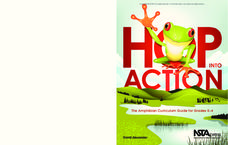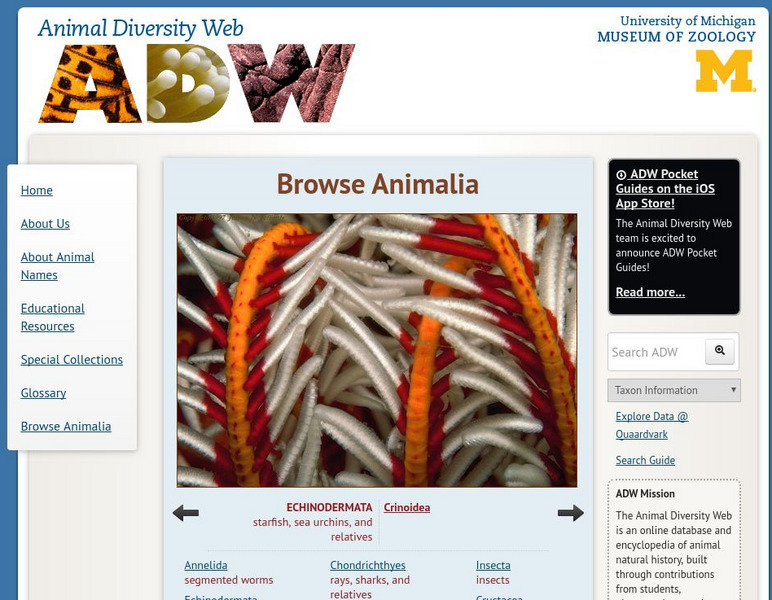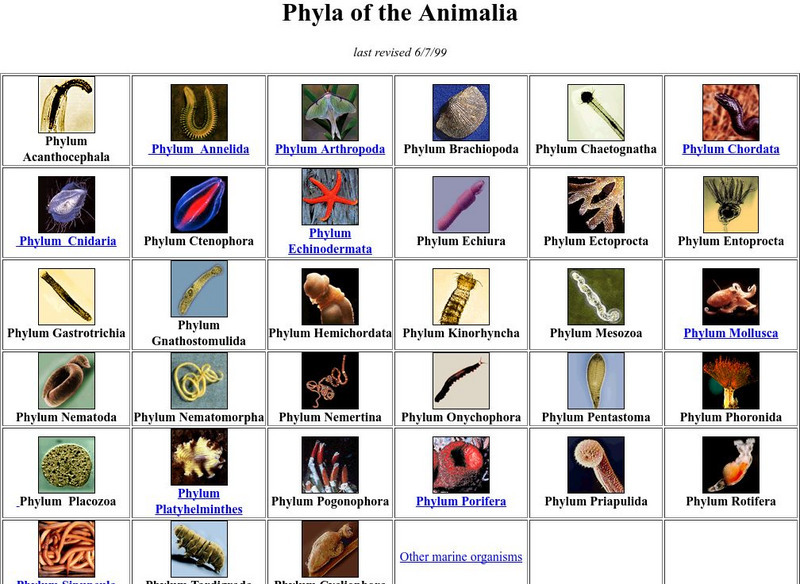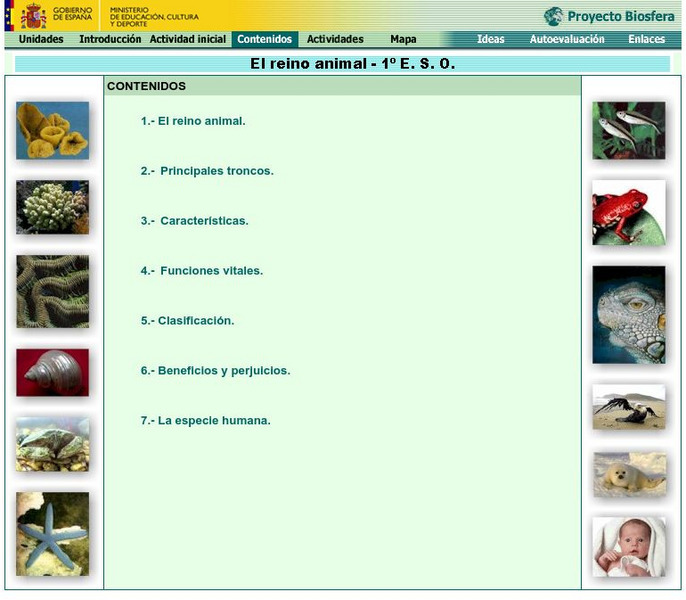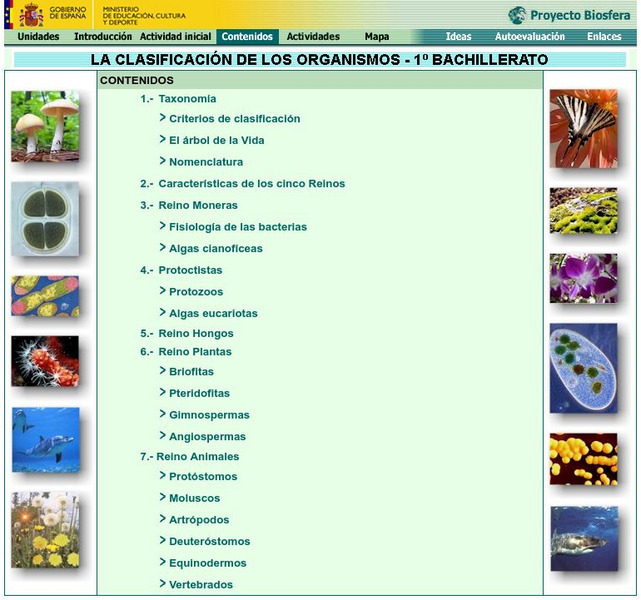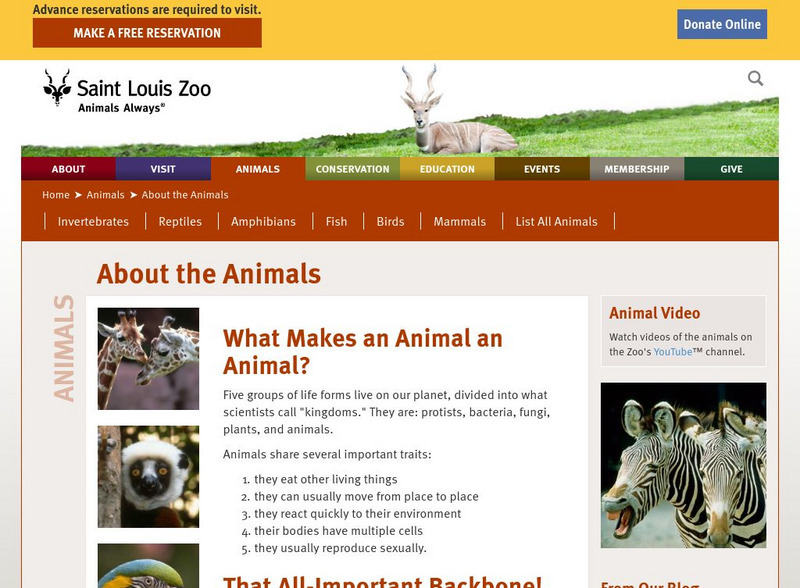Casimir Middle School
Biological Classification Worksheet
Classify living things with a set of worksheets that has pupils sorting and indentifying living and non-living things. Learners use the worksheets as a basis for finding their answers.
MENSA Education & Research Foundation
Kingdom Animalia: Classifying Animals
Six lessons, extension activities, and an assessment make up a series of lessons curated to reinforce the concept of classifying animals. Each informative and interactive lesson attributes to the knowledge of the seven levels of...
Virginia Department of Education
Classification of Organisms
Searching for the perfect indoor/outdoor activity that allows class members the opportunity to learn about organism classification? Here, pupils research organisms and categorize them according to domain and kingdom over the course...
National Science Teachers Association
Hop into Action
Young scientists find out what makes amphibians such unique and interesting animals in this simple life science lesson. After looking at pictures and discussing the characteristics of amphibians, learners complete a series...
Twisty Noodle
Mammals Book
What do a sheep, a boy, and a bat have in common? Learn about mammals with a mini book that lists many different types of mammals. Kids can color the fun illustrations and compile the pages to publish their own mammal books.
Curated OER
Taxonomy Concept Map
Reinforce learners' knowledge of scientific taxonomy with a helpful concept map worksheet. Using a word bank, young biologists fill in the blanks to complete the description of organism classification.
Other
Science4 Us: Animals
In online and offline activities, students broaden their understanding of animals by learning to identify and classify animals into six categories: mammals, birds, fish, amphibians, reptiles, and invertebrates.
Regents of the University of Michigan
Animal Diversity Web: Museum of Zoology: Animal Diversity Web
This resource contains thousands of descriptions about individual animal species. Many of these descriptions also includes pictures, movies, audio clips, and more.
Columbia University
Columbia University: Phyla of the Animalia
Visual and textual information of the major animal phyla with a focus on marine organisms.
University of Guelph
Invertebrates
Site provides a comprehensive guide to anyone seeking information on invertebrates. Provides links to morphology, biodiversity, ecology and habitats.
National Institute of Educational Technologies and Teacher Training (Spain)
Ministerio De Educacion: El Reino Animal 1 Bachillerato
Animals have developed complex equipment and systems, specializing in performing the three functions: nutrition, relationship and reproduction. Learn more about the animal kingdom in this unit. It includes 16 interactive activities.
Estrella Mountain Community College
Estrella Mountain Community College: The Diversity of Life
Detailed information about each of the five kingdoms. Each kingdom is separately described, but information is also summarized in a table.
National Institute of Educational Technologies and Teacher Training (Spain)
Ministerio De Educacion: El Reino Animal
Learn about the animal kingdom including an in-depth look at body characteristics, reproduction, types of cells, ways they obtain food, and evolutionary relationships. Many illustrations and nine interactive activities are included.
National Institute of Educational Technologies and Teacher Training (Spain)
Ministerio De Educacion: La Clasificacion De Los Organismo
This unit will describe the five kingdoms and their main characteristics. It includes 20 interactive activities.
Open Curriculum
Open Curriculum: New Kingdoms
Between 1866 and 1977, a total of four new kingdoms were added to the original plant and animal kingdoms identified by Linnaeus. The new kingdoms include Protista (protists), Fungi, Monera (eubacteria), and Archaea (archaebacteria)....
Other
Panhandle Area Educational Consortium: The Six Kingdoms of Life [Pdf]
Scientists look at the evolutionary history of organisms to divide them into kingdoms. For awhile, there has been 5 kingdoms, but many scientist are now using 6 kingdoms.
Other
University of Aberdeen: The Phyla of Kingdom Animalia
Very systematic breakdown of the animal kingdom starting with the simplest type the sponge, all the way to the chordate or vertebrate. Each phylum has a link with information.
Scholastic
Scholastic: Study Jams! Science: Plants: The Kingdoms of Life
A video, a karaoke song to sing along to, and a 7-question multiple-choice quiz on the topic of Kingdoms in the life classification system.
Regents of the University of Michigan
Animal Diversity Web: Kingdom Animalia
What characterizes animals from plants? General characteristics of the animal kingdom are noted here. Click on Classification for the Kingdom Animalia; clicking on the camera provides pictures of each animal.
Biology 4 kids
Biology4 Kids: The Top Four Kingdoms
Read about the four most familiar kingdoms: fungi, plant, animal, and protist.
Saint Louis Zoo
Saint Louis Zoo: About the Animals: What Makes an Animal an Animal?
Short introduction to animals explains the important traits that all animals share and the differences between vertebrates and invertebrates.
Earth Life
Wonderful World of Insects: An Introduction to the 32 Orders of Insects
A very thorough look at the world of insects. This site examines the 32 orders of insects and gives a complete explanation of the characteristics of each order. Text is supplemented with pictures.
Yale University
Yale New Haven Teachers Institute: Animal Kingdom
Background information about all of the classes of the animal kingdom, followed by four short lesson plan outlines.
Other
The Domains and Kingdoms of Life
This site is a description of the history behind the 5 Kingdom system suggested by Robert Whittaker. An extensive list of resources is included.





